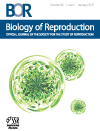-
PDF
- Split View
-
Views
-
Cite
Cite
John J. Eppig, Marilyn J. O’Brien, Development in Vitro of Mouse Oocytes from Primordial Follicles, Biology of Reproduction, Volume 54, Issue 1, 1 January 1996, Pages 197–207, https://doi.org/10.1095/biolreprod54.1.197
Close - Share Icon Share
Abstract
The objective of these studies was to achieve complete oocyte development in vitro beginning with the oocytes in the primordial follicles of newborn mouse ovaries. A two-step strategy was developed: first the ovaries of newborn mice were grown in organ culture for 8 days, and then the developing oocyte-granulosa cell complexes were isolated from the organ-cultured ovaries and cultured for an additional 14 days. The oocytes of primordial follicles are approximately 4190 μm3 in volume (20 μm in diameter), and this volume increased by approximately 53,810 μm3 to a final size of 58,000 μm3—a 13.8-fold increase—during the 8 days of organ culture. In the first experiment the oocyte-granulosa cell complexes were grown in control medium or in medium supplemented with FSH (0.5 ng/ml), epidermal growth factor (EGF; 1.0 ng/ml), or EGF plus FSH. Only 50–60% of the complexes cultured in control medium or in medium supplemented with FSH were recovered at the end of the 14-day culture period. In contrast, more than 90% of the complexes cultured in medium supplemented with EGF were recovered. The median size of the oocytes grown in control medium was 176,800 μm3 (69-μm diameter), while the median size of those grown in medium supplemented with EGF was slightly smaller (136,400-μm3 volume; 63-μm diameter), due to the survival of more smaller-size oocytes in EGF-containing medium. Thirty percent of the oocytes recovered after development in FSH-containing medium were competent to undergo germinal vesicle breakdown (GVB). In the second set of experiments, oocyte-granulosa cell complexes isolated from organ-cultured ovaries were cultured in medium supplemented with either 0.5 or 5.0 ng/ml FSH or with these same concentrations of FSH plus 1.0 ng/ml EGF. Again, increased oocyte recovery was observed in the groups cultured with EGF. There was no difference among the groups in the percentage of the oocytes that acquired competence to undergo GVB (32%) or in the percentage of GVB oocytes that produced a polar body, thus indicating progression of meiosis to metaphase II (22%). When the mature oocytes were inseminated, 21% underwent fertilization and cleavage to the 2-cell stage in the groups without EGF during oocyte development, while 42% underwent fertilization and cleavage to the 2-cell stage in the groups cultured with EGF. Less than 2% of the 2-cell-stage embryos developed to the blastocyst stage in any of the groups. One hundred and ninety 2-cell-stage embryos were transferred to the oviducts of pseudopregnant females; two females produced one pup each; one was living and the other had apparently died recently. The results reported here clearly show that complete development of oocytes in vitro from the primordial follicle stage is possible and establish the framework for further studies using oocytes from laboratory animals as model systems for the development of oocytes from humans as well as from animals of agricultural and zoological importance.
Author notes
This research was performed as part of the National Cooperative Program on Non-Human In Vitro Fertilization and Preimplantation Development and was funded by the National Institute of Child Health and Human Development (NICHD), NIH, through Cooperative Agreement HD21970.



